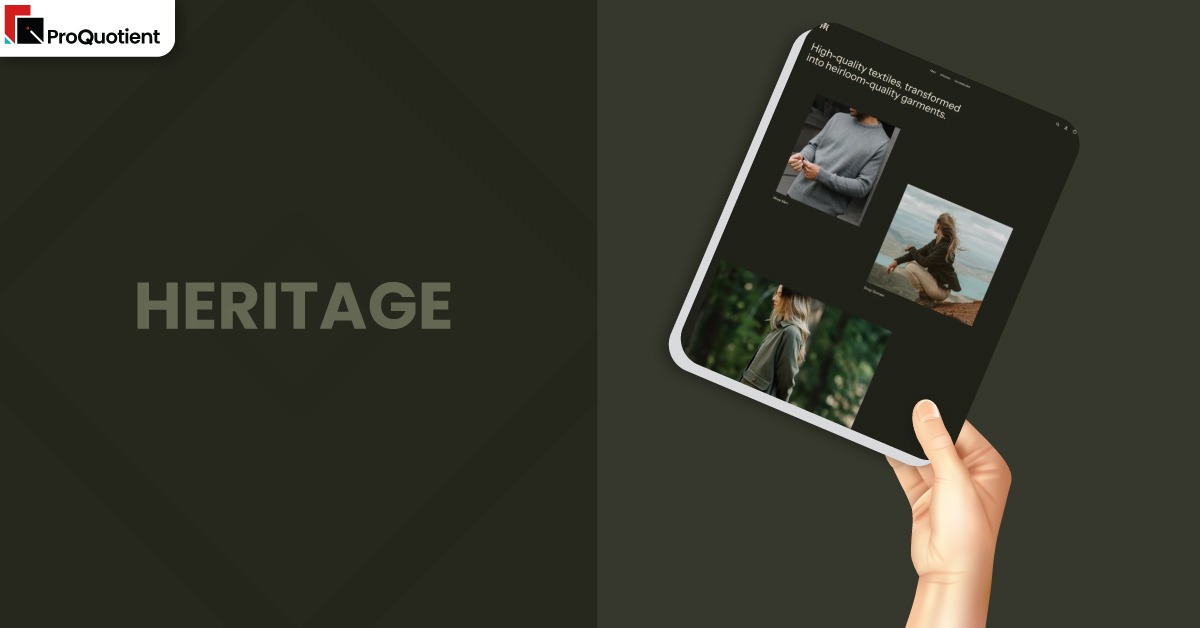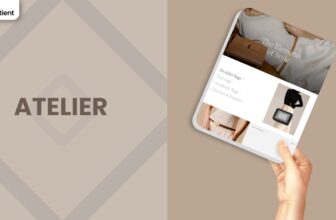Heritage Shopify Theme Review: Classic Structure For Focused Stores

A FREE, block based Shopify theme that keeps things simple while leaving room to grow into more complex layouts.
Introduction
Heritage is a FREE Shopify theme for merchants who want a clean, classic storefront with modern blocks. It favors simple layouts, clear typography, and straightforward navigation so products stay at the center. Many early users like how easy it is to spin up a small side shop or focused project. The Heritage Shopify Theme feels right when you want a simple frame that can still grow with you.
Because it is new, reviews are mixed. Some merchants love the look and appreciate having free swatches and mega menus. Others run into variant picker issues, menu quirks, or swatch setup that needs extra help. The summary below gives you a quick sense of both the promise and the rough edges.
| Summary of Heritage Shopify Theme |
|---|
| Free Shopify theme with a classic, understated design built on flexible block based layouts. |
| Well suited to small catalogs, focused brands, and side projects that need clarity more than visual drama. |
| Includes mega menu support, color swatches, and variant pickers, with some setup required for advanced options. |
| Early reviews highlight attractive design and simplicity, alongside reports of bugs in variants, menus, and carousels. |
| Ideal for merchants who want an easy starting point that still has room for more complex navigation later. |
| As a first version theme, Heritage is still maturing and benefits from close attention to updates and support notes. |
Ideal For Niches With Supporting Features
Heritage is most comfortable when your store does not need intense animation or highly experimental layouts. Its strength lies in keeping pages clear and navigable, while still allowing you to add structure through blocks. That combination suits merchants who care about typography, spacing, and basic hierarchy more than design tricks. The table below matches common niches to the parts of the Heritage Shopify Theme that support them.
| Niches | Supporting Features | Why They Matter? |
|---|---|---|
| Small apparel and accessories brands | Simple product pages, variant pickers, basic swatches | Compact catalogs need product pages that show options clearly without clutter. Heritage’s straightforward layouts help customers identify colors and sizes, provided swatches and variants are configured correctly. |
| Lifestyle and gift shops | Clean navigation, mega menu support, tidy collection grids | Gift and lifestyle buyers like to browse categories. Mega menus and clear collections let them understand assortment at a glance without getting lost in overly complex structures. |
| Craft, furniture, and design pieces | Classic type, calm banners, structured blocks | Design led items look stronger against a restrained background. Soft headings and organized sections help products and photography stand out without additional effects. |
| Simple content plus commerce sites | Space for core pages, blog basics, and featured products | Some merchants run a content light store that still needs pages for FAQs, about, or guides. Heritage’s block system allows you to place simple content alongside products without overwhelming visitors. |
| Side projects and secondary storefronts | Fast initial setup, minimal decoration, low maintenance | When you spin up a new brand or secondary outlet, speed matters. Heritage’s clarity makes it easier to configure a serviceable store quickly and improve it over time. |
Presets
Heritage does not ship with dramatic presets. Instead, its personality comes from the colors, fonts, and blocks you choose. Soft neutrals and gentle type create a calm, editorial feel for lifestyle or craft brands. Stronger contrasts and tighter spacing make it better suited to apparel, accessories, or street inspired catalogs. Whatever direction you choose, keep styling consistent so the Heritage Shopify Theme feels intentional, not like a mix of unrelated pages.
Key Features And Highlights
Because Heritage is a newer theme, its feature set is still taking shape. It includes the core elements most small to mid sized stores need while hinting at future flexibility with mega menus and swatches. For merchants who want a simple starting point, that mix can be enough. The table below focuses on the features that are most likely to affect daily store operations.
| Features | What It Is And Why It Matters? |
|---|---|
| Classic header and navigation | Heritage uses a simple header with room for logo, navigation, and icons. This keeps primary paths obvious so visitors know where to go next. Some merchants want additional styling controls and font options for the mega menu, which may arrive in later updates or through customization. |
| Mega menu capabilities | The theme supports mega menus, which help reveal deeper site structure in a single view. That is important once your catalog grows or you want to group content around themes. Early users request more styling controls, indicating that the underlying structure is present but the design layer could expand. |
| Variant picker and swatches | Heritage can show color swatches and variant options on product pages. When configured correctly, customers can see choices at a glance instead of reading long dropdowns. Some reviewers initially struggle with swatch setup or variant pickers not behaving as expected, often resolving it through Help Center guidance or support. |
| Product page blocks | Product pages use blocks for descriptions, details, and additional content. This lets you stack information in a way that matches your product type. For example, you can place key selling points high on the page while moving secondary details into collapsible sections lower down. |
| Simple, focused collection grids | Collection pages present tidy rows of products without distracting extras. That suits smaller assortments and brands that want to highlight quality over volume. Clear pricing and concise titles help visitors understand offerings quickly and move into product detail when ready. |
| Search and discovery tools | Out of the box, Heritage provides a search icon that opens a search interface. Some merchants would like a permanently visible search bar, particularly for catalog heavy stores. This can sometimes be implemented using design time or custom work, giving search a more prominent role. |
| Carousel and media sections | Heritage includes carousel and image banner sections for showing multiple visuals in a compact space. These are helpful for highlighting key collections, campaigns, or lookbook style sequences. A few early reviews mention carousel quirks, such as arrow placement, which are likely to be refined over future updates. |
| Footer with policies and links | The footer supports policy links, navigation items, and contact or social information. This area anchors trust by making important information easy to find. Using it well helps your store feel complete without stuffing the header with every possible link. |
| Template and block flexibility | Because Heritage is built on modern Shopify blocks, you can create different templates for specific products or pages. This matters when parts of your catalog need extra content or when you are experimenting with landing pages. Blocking out these layouts keeps your code base simpler than fully custom themes. |
| Typography and spacing controls | Basic controls for font pairings, sizes, and spacing allow you to shift the tone from playful to serious. This makes the theme adaptable across industries while still feeling cohesive. Merchants who want very fine control over typography may still lean on custom CSS or design services. |
Theme Experience!

From a shopper’s viewpoint, Heritage is meant to feel straightforward and predictable. It does not try to impress with animation or heavy visual tricks. Instead, it guides people through a conventional journey from homepage to collection to product. The table below outlines what that experience typically feels like when the Heritage Shopify Theme is configured carefully.
| Experience Area | What Shoppers Feel In Practice? |
|---|---|
| Landing on the homepage | Visitors arrive on a layout that looks clear and uncluttered. They see a banner or feature area, then direct paths into key collections. The site feels approachable rather than intimidating, which can build trust for new brands. |
| Navigating categories | The main menu and any mega menu present categories in a familiar way. Shoppers can see where to find apparel, accessories, or other ranges without guessing. As long as menu items are labeled clearly, the structure fades into the background. |
| Exploring products | Product pages show images, options, and descriptions in a tidy stack. Variant pickers or swatches make it simple to switch between colors or sizes once they are configured properly. Customers do not have to fight the layout to learn what they need. |
| Using search and discovery | The search icon and simple collection layouts help visitors who know what they want. They can either search directly or browse through small groups of items. Some stores may choose to surface search more prominently for catalog heavy experiences. |
| Reaching checkout | Cart and checkout handoff remain consistent with the rest of the theme. Shoppers see line items, totals, and the path forward without distractions. This continuity reassures people that the store is stable and trustworthy. |
Performance, Explained!
Performance on Heritage is tied to your content choices and to the fact that it is still a young theme. Keep image files lean, limit how many heavy sections you stack above the fold, and resist loading too many apps. Test on current phones as well as desktop so you can catch layout or scroll issues early. As updates roll out, revisit your live store to confirm that new features have not slowed key pages.
Pricing
Heritage is free in the Shopify Theme Store, so there is no up front license cost. That makes it appealing for side projects, small catalogs, or test brands where you want a clean frame without spending. You can install it, build a draft, and publish once you are confident in the layout. The real investment is your time, not a theme invoice.
Stores Build with Heritage Shopify Theme
Stores using Heritage tend to lean into simplicity. Many examples keep homepages short, with a hero, a couple of key collections, and a straightforward footer. This suits brands that want to present a focused set of products rather than a sprawling catalog. The consistent typography and grid system make even small collections feel organized and intentional.
Some merchants use Heritage as a base for more experimental navigation or mega menu structures. Others treat it as a minimal frame for side businesses or secondary lines that do not need a complex experience. Across these stores, the strongest impressions come from clear product photos and honest copy, rather than visual effects. If you approach the Heritage Shopify Theme as a steady foundation, it can serve a variety of brand stories.
Examples of businesses using Heritage include:
- Buckley Network
- BONE & WOOD
- Fatch Apparel
- LoversOnlyWorld888
- Chronomade
- ALIZA
- Outfit HARO
Themes Similar to Heritage
Heritage sits alongside several other free themes that deliver clean layouts and modern blocks. Comparing them helps you decide whether you want something more opinionated or more neutral. Some alternatives lean heavier into storytelling, while others focus on performance and minimalism. The table below places Heritage among those peers.
| Shopify Theme | FREE or Paid? | Why is it Similar? |
|---|---|---|
| Dawn | FREE | Dawn is the reference free theme, with a neutral aesthetic and strong performance. It shares Heritage’s clarity and block based structure, but has been refined over more iterations and usually feels more battle tested. |
| Origin | FREE | Origin offers a simple, flexible base that adapts across industries. It resembles Heritage in its straightforward layouts, yet leans slightly more toward general purpose commerce than classic styling. |
| Dwell | FREE | Dwell is another modern block theme that suits home and lifestyle brands. It feels denser and more feature rich than Heritage, which remains more stripped back and focused. |
| Craft | FREE | Craft targets artisans and decor brands that rely on storytelling and process. It has a warmer, more editorial tone, while Heritage stays closer to a traditional storefront style. |
| Ride | FREE | Ride is aimed at sports and high energy brands. It provides a useful contrast to Heritage if you are deciding between calm, classic layouts and bold, dynamic ones. |
Pros and Cons
Heritage’s strengths and weaknesses are closely tied to its youth. It delivers a clean, classic experience for shoppers and a straightforward setup for merchants. At the same time, it has fewer real world miles than older free themes and shows some early issues in reviews. The list below captures the main pros and cons to consider.
| Pros | Cons |
|---|---|
| Free theme with a classic, understated aesthetic that suits focused catalogs and side projects. | Some merchants report issues with variant pickers, swatches, and carousels that require extra support or configuration. |
| Simple navigation and clean collection grids make stores easy to understand and browse. | Styling options for mega menus, fonts, and certain elements feel limited for highly design driven brands. |
| Built on blocks, with support for mega menus and swatches, giving room to grow over time. | As a very new theme, Heritage may contain more undiscovered bugs and requires careful attention to updates and help documentation. |
Our Rating
Because Heritage is new, its ratings reflect both potential and early stage quirks. Some merchants see it as exactly what they needed for a simple, attractive store. Others bump into variant picker or menu issues that need support or custom work. The table below summarizes how we see the Heritage Shopify Theme at this stage.
| Parameters | Our Ratings | Summary |
|---|---|---|
| Feature Depth | 3.8/5.0 | Heritage includes essential features such as mega menus, swatches, and flexible templates. For many small stores, that is enough to launch and trade. Larger or more specialized catalogs may quickly look for additional tools or customization. |
| Design and Customization | 4.1/5.0 | The design is clean, modern, and adaptable to several niches. Basic controls over colors, type, and blocks give merchants room to shape their own aesthetic. Requests for more menu styling and font options suggest there is still room to grow. |
| Performance | 4.0/5.0 | There are not yet widespread complaints about speed, and the relatively simple layouts give a good starting point. As with any theme, heavy images and numerous apps can change that picture. Regular testing on live devices is still important. |
| Value for Money | 4.8/5.0 | As a free theme with a thoughtful, classic design, Heritage offers great value. It is particularly appealing for side projects or new brands that want to look professional without paying for a premium theme. |
| Support and Updates | 3.8/5.0 | Developers appear to be listening closely to early feedback, especially around bugs and requested features. At the same time, some issues such as variant picker confusion or carousel quirks show that this is still a first version theme. Close collaboration with support is advised. |
| Overall | 4.0/5.0 | Overall, the Heritage Shopify Theme is a promising choice for merchants who prioritize simplicity and clarity. It can anchor a small or growing store effectively, provided you are comfortable dealing with early stage rough edges and incremental improvements. |
User Reviews: What Merchants Say
Early feedback on Heritage reflects both enthusiasm and understandable caution. Some merchants, like Buckley Network and LoversOnlyWorld888, are delighted to have a cool, free theme that makes their stores look clean and professional. Others praise how well it works for simple or side projects and appreciate that it can be styled for more complex uses later. The general tone from this group is gratitude for a fresh design that keeps things straightforward.
On the critical side, several users mention problems with variants and swatches not working correctly at first. There are also comments about menus not displaying fully, carousel controls sitting in odd positions, and the theme feeling very new. In many cases, responses point to configuration steps, design time, or future updates as potential solutions. Taken together, the sentiment is that the Heritage Shopify Theme is promising, but best suited to merchants who are comfortable experimenting and talking with support while it matures.
Our Verdict
Heritage is a promising free choice if you want a straightforward, classic layout that keeps focus on products. It suits simpler catalogs, side brands, or early stage stores where clean navigation matters more than visual tricks. Because it is a new theme, you should expect occasional rough edges and rely on support or design help for specific tweaks. If you are comfortable with that trade off, the Heritage Shopify Theme can grow alongside your business.
GET THE BEST APPS IN YOUR INBOX
Don't worry we don't spam








